C1.3 Determine pattern rules and use them to extend patterns, make and justify predictions, and identify missing elements in repeating and positioning patterns.
Skill: Determining and Using Rules to Extend Patterns, Make and Justify Predictions, and Find Missing Terms
Describing pattern rules in everyday language is an important step in the development of algebraic thinking.
Patterns can be described using functional thinking and recursive thinking. Describing the relationship between the term number and the term value is functional thinking. For example, each term has a value that is twice its term number. Recursive thinking can be used to make near predictions. Functional thinking tends to be used to make far predictions, such as what is the 25th term?
It is important to recognize that the path to the expression of a matching rule may differ from person to person, since reasoning develops from individual perceptions. The example below, inspired by research conducted by Radford ("Algebraic thinking and the generalization of patterns: a semiotic perspective", in J. L. C. S. Alatorre, M. Sáiz, A. Méndez (Eds.), Proceedings of the 28th Conference of the International Group for the Psychology of Mathematics Education, North American Chapter, vol. 1, Mérida, Mexico, 2006, pp. 2-21, as cited in Ontario Ministry of Education, A Guide to Effective Instruction in Mathematics, Grades 4-6: Modeling and Algebra, 2008, p. 54), illustrates how students may perceive the relationship between the term number and the term value (number of circles).
Example 1
 Image Non-numeric positioning pattern of yellow circles. Term one, 5 yellow circles. Term 2, 7 yellow
circles. Term 3, 9 yellow circles.
Image Non-numeric positioning pattern of yellow circles. Term one, 5 yellow circles. Term 2, 7 yellow
circles. Term 3, 9 yellow circles.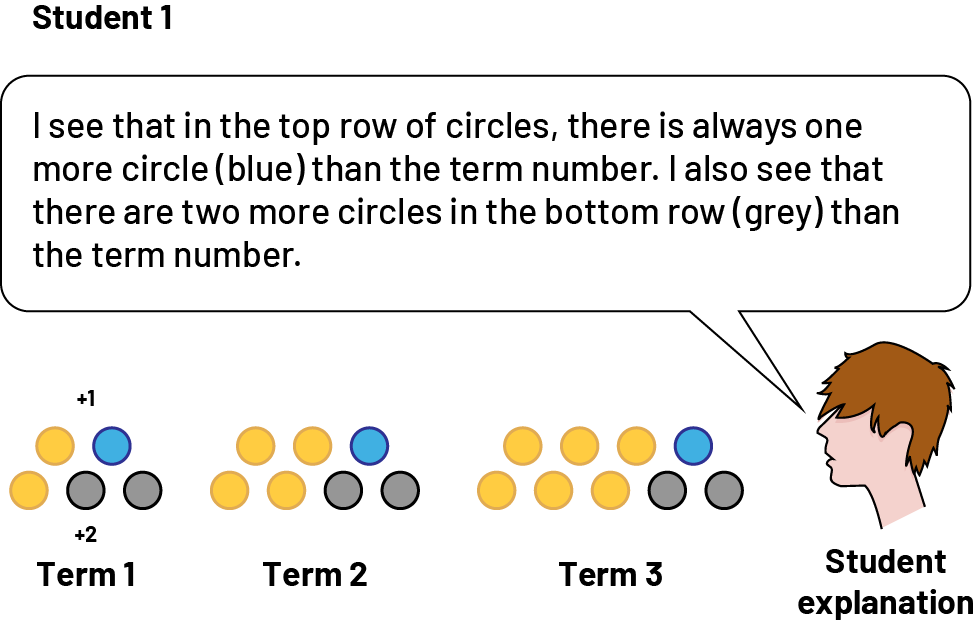 Image “I see 2 circles in the upper position, there is always 1 circle
more (in blue) than the term position and in the lower position, there are always 2 circles more (in grey) Non-numeric
positioning pattern of yellow circles”. Term one, 5 circles made up of 2 yellow, 2 gray, and one blue circles. Term
2, 7 circles made up of 4 yellow, 2 gray, and one blue circles. Term 3, 9 circles made up of 6 yellow , 2 gray, and
one blue circles.
Image “I see 2 circles in the upper position, there is always 1 circle
more (in blue) than the term position and in the lower position, there are always 2 circles more (in grey) Non-numeric
positioning pattern of yellow circles”. Term one, 5 circles made up of 2 yellow, 2 gray, and one blue circles. Term
2, 7 circles made up of 4 yellow, 2 gray, and one blue circles. Term 3, 9 circles made up of 6 yellow , 2 gray, and
one blue circles.
Continuing their analysis, the student determines that the term in the 10th term will contain (10 + 1) + (10 + 2) circles, or 23 circles.
 Image “To find the total number of circles, you add twice the term of the term and add 3. So, for term
1, the number sentence is one, plus, 3, equals, 5 for term 2, 2, plus, 2, plus, 3, equals, 7 and for term 3, 3, plus,
3, plus, 3, equals, 9”. Non-numeric positioning pattern of yellow circles. Term one, 5 circles made up of 2 yellow
and 3 blues circles. Term 2, 7 circles made up of 4 yellow and 3 blue circles. term 3, 9 circles made up of 6 yellow
and 3 blue circles.
Image “To find the total number of circles, you add twice the term of the term and add 3. So, for term
1, the number sentence is one, plus, 3, equals, 5 for term 2, 2, plus, 2, plus, 3, equals, 7 and for term 3, 3, plus,
3, plus, 3, equals, 9”. Non-numeric positioning pattern of yellow circles. Term one, 5 circles made up of 2 yellow
and 3 blues circles. Term 2, 7 circles made up of 4 yellow and 3 blue circles. term 3, 9 circles made up of 6 yellow
and 3 blue circles. Image “In position 1, I see 5 circles. In position 2, I see the 5
initial circles, to which we added 1 group of 2 circles. In position 3, I see the 5 initial circles, to which we added
2 groups of 2 circles”. Non-numeric positioning pattern of yellow circles. Term one, 5 yellow circles. Term 2, 7
circles made up of 5 yellow and 2 blue circles. Term 3, 9 circles made up of 5 yellow and 4 blue circles.
Image “In position 1, I see 5 circles. In position 2, I see the 5
initial circles, to which we added 1 group of 2 circles. In position 3, I see the 5 initial circles, to which we added
2 groups of 2 circles”. Non-numeric positioning pattern of yellow circles. Term one, 5 yellow circles. Term 2, 7
circles made up of 5 yellow and 2 blue circles. Term 3, 9 circles made up of 5 yellow and 4 blue circles.
Note: Students may present their interpretation using a chart.
| Term number | Number of Circles | Explanation using the Recursive Relationship | Explanation using the Functional Relationship |
|---|---|---|---|
| 1 | 5 | 5 | 5 + 0 x 2 |
| 2 | 7 | 5 + 2 | 5 + 1 x 2 |
| 3 | 9 | 5 + 2 + 2 | 5 + 2 x 2 |
| 4 | 11 | 5 + 2 + 2 + 2 | 5 + 3 x 2 |
| 25 | ? | 5 + 2 + 2 + 2 + ... | 5 + 24 x 2 |
The pattern rules formulated by the three students came from their understanding of this relationship. Each student has perceived and generalized the situation in his or her own way, resulting in three rules expressed in different, but equivalent, words. None is better than the other. They do, however, demonstrate that students' interpretation of a relationship has an effect on the pattern rule they formulate. It is important for teachers to encourage these different formulations of a pattern rule.
There may be students who move too quickly from the non-numeric pattern to the corresponding table of values. Starting with the previous non-numeric pattern, for example, they can immediately establish the following table.
| Term Number | 1 | 2 | 3 |
|---|---|---|---|
| Number of Circles | 5 | 7 | 9 |
Students then proceed by trial and error to determine the rule that defines the relationship, as evidenced by the student's explanations below. In each case, the depth of these students' understanding of the relationship it represents should be questioned.
 Image “I represented the relationship by a Value tables. I compared the term to the number of
corresponding circles by making several trials. For example, I started with x 2, but it didn't work; then I tried x 3,
but it didn't work either. I continued in this way and found that in each case it was "times two plus three or double
the term plus 3”.
Image “I represented the relationship by a Value tables. I compared the term to the number of
corresponding circles by making several trials. For example, I started with x 2, but it didn't work; then I tried x 3,
but it didn't work either. I continued in this way and found that in each case it was "times two plus three or double
the term plus 3”.
Teachers need to consider the different ways that students perceive the relationships between terms in a pattern and adapt their questioning accordingly to help each student accurately express the rule in words. The following situation highlights examples of adaptive questioning.
Example 2
Present the following situation.
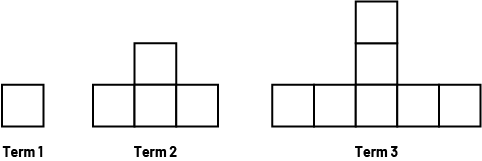
Using the following questions, encourage students to analyze the pattern and relate the term number with the number of squares it has:
- How many squares does term 1, 2, and 3 have?
- How many squares are needed to construct term 4 ? Construct this term.
- How many squares are needed to construct term 5 ? Construct this term.
 Image
Non-numeric pattern with positioning patterns. term one, one square. term 2, 4 squares. term 3, 7 squares. term 4, 10
squares. term 5, 13 squares.
Image
Non-numeric pattern with positioning patterns. term one, one square. term 2, 4 squares. term 3, 7 squares. term 4, 10
squares. term 5, 13 squares.
- What pattern rule can be used to determine the number of squares?
- Represent the relationship between the term number and the number of squares in each term using a table of values. What patterns do you notice in the table?
- How many squares will term 6 have? term 10 ? How do you know?
- What is another way this can be determined?
Then facilitate a mathematical discussion that focuses on students' different perceptions of the relationship. Ask them questions, such as the ones below, to get them to explain and verbalize their strategy and rule.
- What strategy did you use to count the number of squares in the 4th term?
Student 1: "For term 4, I see that there are three squares on the left, three squares on the right, three squares at the top and one square in the middle, at the bottom. That's 3 + 3 + 3 + 1, or 10 squares."
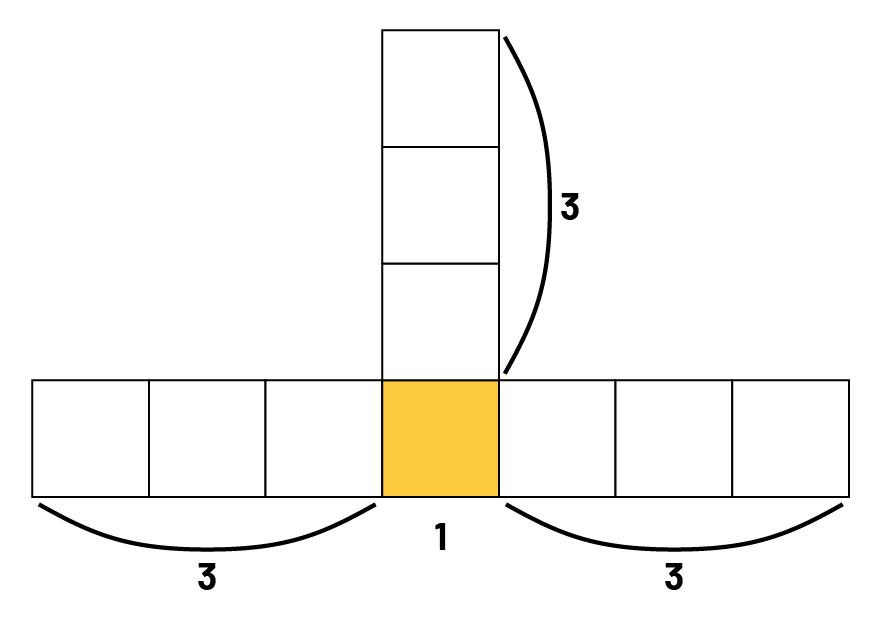 Image
term is made up of ten squares. One yellow square is found at the center of a 7 square
position. 7 squares are side by side horizontally, 3 squares are on top of another vertical square named ‘one’ at
the center.
Image
term is made up of ten squares. One yellow square is found at the center of a 7 square
position. 7 squares are side by side horizontally, 3 squares are on top of another vertical square named ‘one’ at
the center.
- Who used the same strategy? Did anyone use a different strategy?
Student 2: "I used a similar strategy. I see one square in the centre, and three branches of three squares. In total, that's 10 squares."
 Image
term is made up of ten squares. One yellow square is found at the center of a 7 square
position. 7 squares are side by side horizontally, 3 squares are on top of another vertical square named ‘one’ at
the center.
Image
term is made up of ten squares. One yellow square is found at the center of a 7 square
position. 7 squares are side by side horizontally, 3 squares are on top of another vertical square named ‘one’ at
the center.
Student 3: "My strategy is different, but I got the same answer. I see a column of four squares, then three squares on the left and three squares on the right. In total, I counted 4 + 3 + 3, which is 10 squares.."
 Image
term made up of ten squares. 7 squares are side by side horizontally, 3 yellow squares are
on top of another vertical square named ‘one’ of the center.
Image
term made up of ten squares. 7 squares are side by side horizontally, 3 yellow squares are
on top of another vertical square named ‘one’ of the center.
Student 4: "I see the squares in a different way. If I look at the pattern, it starts with a square and in each term, a square is added in three places. In the fourth term, the three squares have been added three times. In all, we have 10 squares."
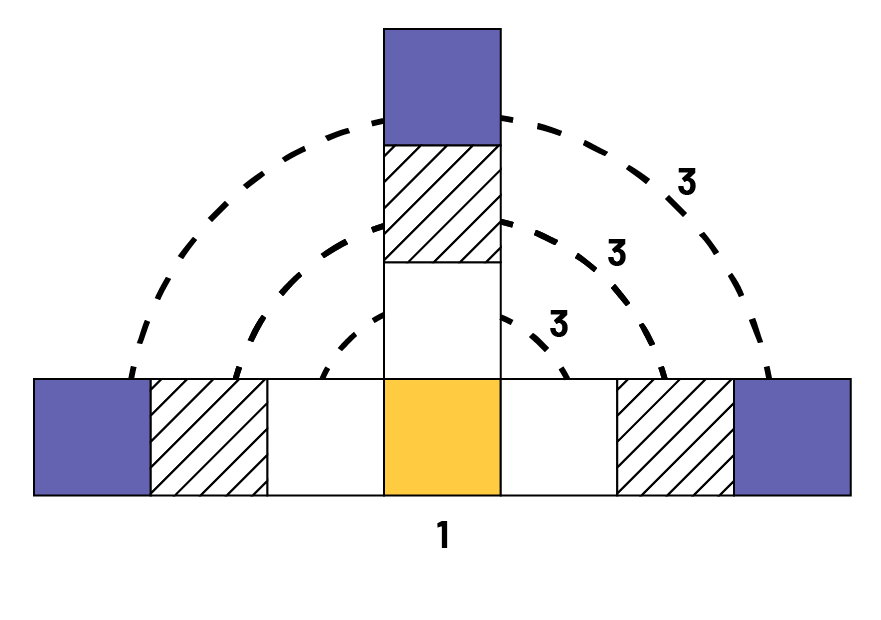 Image
term made up of ten squares. 7 squares are side by side horizontally, 3 squares are on top
of another vertical square named ‘one’ in the center. Dotted lines make an arc with the number 3 on each position
of squares.
Image
term made up of ten squares. 7 squares are side by side horizontally, 3 squares are on top
of another vertical square named ‘one’ in the center. Dotted lines make an arc with the number 3 on each position
of squares.
- Does your strategy work for counting the number of squares in term 5?
Student 1: "Yes. I see that there are four squares on the left, four squares on the right, four squares at the top, and one square in the middle, at the bottom. That's 4 + 4 + 4 + 1, or 13 squares."
 Image
term made up of ten squares. 7 squares are side by side horizontally, 3 squares are on top
of another vertical square named ‘one’ in the center. Dotted lines make an arc with the number 3 on each position
of squares.
Image
term made up of ten squares. 7 squares are side by side horizontally, 3 squares are on top
of another vertical square named ‘one’ in the center. Dotted lines make an arc with the number 3 on each position
of squares.
Student 2: "Yes. I see a square in the middle at the bottom and three branches of four squares. That's a total of 13 squares."
 Image
term is made up of ten squares. One yellow square is found at the center of a 7 square
position. 7 squares are side by side horizontally, 4 squares are on top of another vertical square named ‘one’
at
the center.
Image
term is made up of ten squares. One yellow square is found at the center of a 7 square
position. 7 squares are side by side horizontally, 4 squares are on top of another vertical square named ‘one’
at
the center.
Student 3: "Yes. I see a column of five squares, then four squares on the left and four squares on the right. In total, I count 5 + 4 + 4, which is 13 squares."
 Image
term made up of ten squares. 7 squares are side by side horizontally, 4 yellow squares are
on top of another vertical square named ‘one’ in the center.
Image
term made up of ten squares. 7 squares are side by side horizontally, 4 yellow squares are
on top of another vertical square named ‘one’ in the center.
Student 4: "Yes. If I look at the pattern, it starts with a square, and in each term a square is added in three places. In term 5, we add the three squares four times. In all, we have 13 squares."
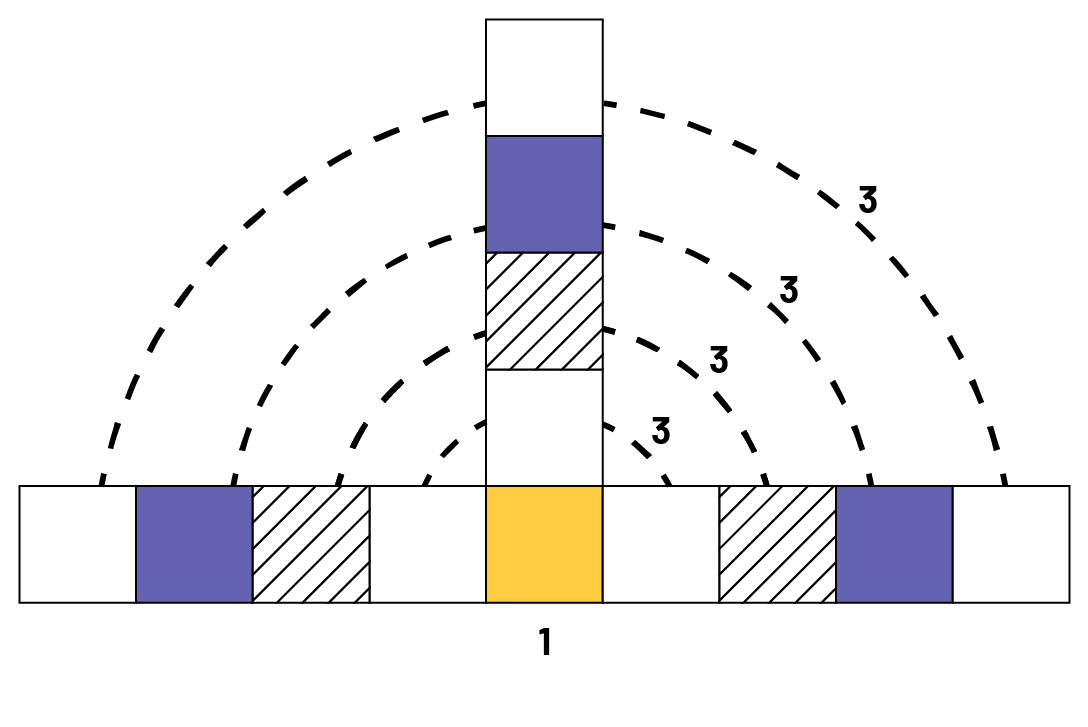 Image
term made up of ten squares. 7 squares are side by side horizontally, 4 squares are on top
of another vertical square named ‘one’ in the center. Dotted lines make an arc with the number 3 on each
position
of squares.
Image
term made up of ten squares. 7 squares are side by side horizontally, 4 squares are on top
of another vertical square named ‘one’ in the center. Dotted lines make an arc with the number 3 on each
position
of squares.
- According to your strategy, how many squares will there be in term 10?
Student 1: "In the 10th term, there will be 28 squares. There will be one square in the middle, at the bottom, nine squares on the left, nine squares on the right, and nine squares at the top. In total, there will be 9 + 9 + 9 + 1, which is 28 squares."
- How do you know how many will be on the left, right and top?
Student 1: "Looking from one term to the next, there is always one square less than the term number in each of these three places."
Student 2: "My strategy is pretty well the same thing."
- How might your strategy differ?
Student 2:"They added 9 + 9 + 9 but I multiplied instead. I did 3 × 9 and then added 1."
Student 3: "I also got 28. There will be a column of 10 squares in the middle, with nine squares on the left and nine squares on the right, so 10 + 9 + 9 = 28 squares."
- How do you know it's 10 squares, then nine squares twice?
Student 3: "From the first terms in the pattern, the number of squares in the middle column is equal to the term number and the number of squares on the left and right is always 1 less than that term number."
Student 4: "The way I see the number of squares in each term, is that there is one square in the middle at the bottom. In the first term, we add three squares – one to the left, one to the right and one on top. One square is continued to be added to the left, right and top in terms 2 through 10, so nine times. In all, we will have 1 + (9 × 3), or 28 squares."
Note: Even though the calculations performed are similar, the students saw an arrangement of the squares in different ways and as a result they generated different, but equivalent, pattern rules.
- Can your strategy be used to determine the number of squares that will be in the 25th term?
Have students explain in words how to determine the value of a distant term (for example, term 10 or 25) in relation to the term number.
Some students may have difficulty in identifying the quantities involved. It is important to ask them questions such as the ones presented below to get them to express their pattern rule more clearly.
- How can you determine the number of squares for any term number?
Student 1: "To determine the number of squares for any term, I add a number three times, then add one."
 Image term is made up of ten squares. One yellow square is found at the center of a 9 square
position. 9 squares are side by side horizontally, 4 squares are on top of another vertical square named ‘one’
at
the center.
Image term is made up of ten squares. One yellow square is found at the center of a 9 square
position. 9 squares are side by side horizontally, 4 squares are on top of another vertical square named ‘one’
at
the center.
- What is this number? How can you identify or name it?
Student 1: "It is always the previous term number."
- How can you express your pattern rule for determining the number of squares for any term more accurately?
Student 1: "To determine the number of squares for any term number, I add the term number of the previous term 3 times, then add 1."
Student 2: "To determine the value of any term, I multiply by three and add one."
 Image term is made up of ten squares. One yellow square is found at the center of a 9 square
position. 9 squares are side by side horizontally, 4 squares are on top of another vertical square named ‘one’
at
the center.
Image term is made up of ten squares. One yellow square is found at the center of a 9 square
position. 9 squares are side by side horizontally, 4 squares are on top of another vertical square named ‘one’
at
the center.
- What do you multiply by three?
Student 2: "I multipled the previous term number by 3."
Student 3: "Each term has three branches. One branch has the same number of squares as the term number and the two others branches have one less square than the term number. To determine the total number of squares, I add these three numbers together."
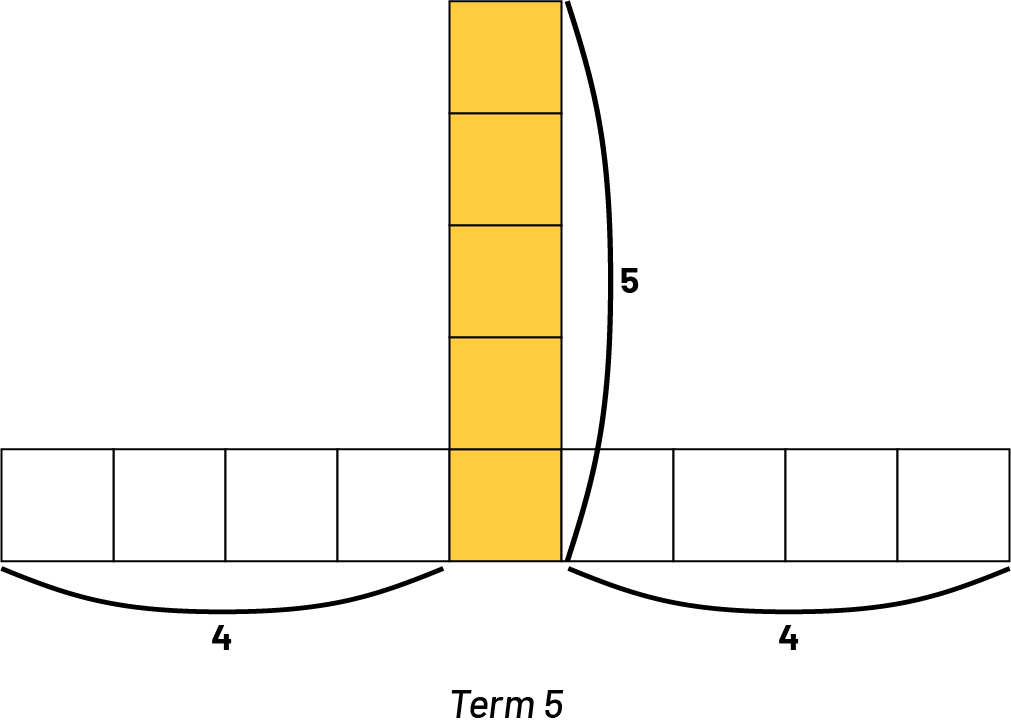 Image term made up of ten squares. 7 squares are side by side horizontally, 4 yellow squares are
on top of another vertical square named ‘one’ in the center.
Image term made up of ten squares. 7 squares are side by side horizontally, 4 yellow squares are
on top of another vertical square named ‘one’ in the center.
- Can you explain your pattern rule in another way?
Student 3: "To determine the number of squares that make up a term given any term number, I add 2 values, the term number of the term and two times the previous term."
Student 4: "I multiply the previous term number by three and add one."
 Image
term made up of ten squares. 7 squares are side by side horizontally, 4 squares are on top
of another vertical square named ‘one’ in the center. Dotted lines make an arc with the number 3 on each
position
of squares.
Image
term made up of ten squares. 7 squares are side by side horizontally, 4 squares are on top
of another vertical square named ‘one’ in the center. Dotted lines make an arc with the number 3 on each
position
of squares.
Teachers then prompt students to check the validity of their pattern rule. To validate the rules, a table of values is used.
In the previous example students extended the pattern, analyzed the pattern to describe a rule, and created a table of values showing the term values for each term number, and were asked to make connections between each of the representations.
Example 3
For this pattern, let's study the relationship between each term number and their number of squares.
 Image Non-numeric positioning pattern of the term of terms and squares. term one, 2 squares. term
2,
6 squares. term 3, 12 squares, term 4, 20 squares.
Image Non-numeric positioning pattern of the term of terms and squares. term one, 2 squares. term
2,
6 squares. term 3, 12 squares, term 4, 20 squares.
At first glance, this pattern may seem very complex, because the number of squares (2, 6, 12, 20, …) that make up each term does not have a simple pattern rule. Before putting such a pattern aside, it is important to examine it more closely. Let's continue to explore this pattern by extending and analyzing the pattern, constructing a table of values, and then describing the relationship with words.
Extending a Geometric Pattern
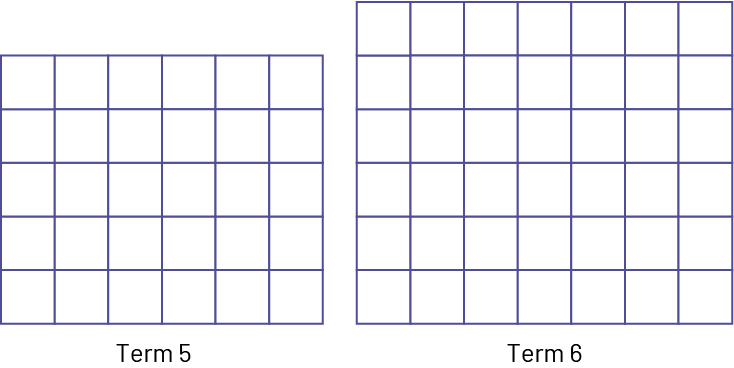
Analyzing the Pattern
The shaded squares represent the squares added on from term to term.
 Image Geometric pattern of the term numbers and two different colour squares. term one, 2 squares.
term 2, 2 squares and 4 dark blue squares. term 3, 6 squares and 6 dark blue squares. term 4, 12 squares, 8 dark
blue colour squares.
Image Geometric pattern of the term numbers and two different colour squares. term one, 2 squares.
term 2, 2 squares and 4 dark blue squares. term 3, 6 squares and 6 dark blue squares. term 4, 12 squares, 8 dark
blue colour squares.
The number of squares increases by 4, by 6, by 8, and so on. These quantities can be observed in the geometric pattern.
To move from the 1st term to the 2nd term, four squares are added - which can be viewed as two squares and a column of two squares.
To move from the 2nd term to the 3rd term, six squares are added - which can be viewed as three squares and a column of three squares.
To move from the 3rd term to 4th term, eight squares are added - which can be viewed as four squares and a column of four squares.
Table of Values
The table of values is a numeric representation of this pattern.
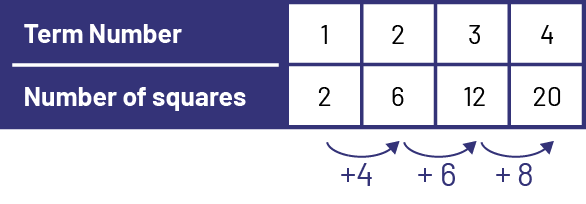 Image Table of values that represents the term numbers and the number of squares. term one, 2
squares. term 2, 6 squares. term 3, 12 squares. term 4, 20 squares. Pattern rule of plus 4, plus 6, plus 8.
Image Table of values that represents the term numbers and the number of squares. term one, 2
squares. term 2, 6 squares. term 3, 12 squares. term 4, 20 squares. Pattern rule of plus 4, plus 6, plus 8.
Describing a Pattern Rule Using Words
Describing the pattern rule recursively, the number of squares that the pattern increases by is two more each time (4, 6, 8, xxx).
Describing the pattern rule functionally, we need to analyze the relationship between the term number and the number of squares in it.
- In the 1st term, there are two columns of one square.
- In the 2nd term, there are three columns of two squares.
- In the 3rd term, there are four columns of three squares.
- In the 4th term, there are five columns of four squares.
- So in the 10th term, there will be 11 columns of 10 squares.
- The number of columns is always one more than the term number and the number of squares in each column is always equivalent to the term number.
Source: translated from Guide d’enseignement efficace des mathématiques de la 4e à la 6e année, Modélisation et algèbre, p. 52-65.
Knowledge: Recursive Relationship
Recursive Pattern Rule: a rule that describes a pattern by what changes from one term to the next.
A) Repeating Pattern
 Image Geometric pattern with repeating patterns: pattern A: term one to 9, rectangle, trapezoid,
triangle, repeated 3 times.
Image Geometric pattern with repeating patterns: pattern A: term one to 9, rectangle, trapezoid,
triangle, repeated 3 times.
Pattern rule: pattern core is blue rectangle, green trapezoid, orange triangle.
B) Geometric Pattern
Pattern rule: a square is added from one term to the next.
 Image Non-numeric pattern with positioning patterns. pattern “B”. Term one: one square. Term 2:
two
squares. Term 3: 3 squares.
Image Non-numeric pattern with positioning patterns. pattern “B”. Term one: one square. Term 2:
two
squares. Term 3: 3 squares.
C) Geometric Pattern and Table of Values
Pattern rule: one more cube is added to the bottom row from one term to the next.
 Image Geometric pattern with growing patterns. Term one, 2 cubes. Term 2, 3 cubes. Term 3, 4
cubes.
Image Geometric pattern with growing patterns. Term one, 2 cubes. Term 2, 3 cubes. Term 3, 4
cubes.
 Image Table of values represents the term number and the number of cubes. Term one, 2 cubes.
Term 2, 3 cubes. Term 3, 4 cubes.
Image Table of values represents the term number and the number of cubes. Term one, 2 cubes.
Term 2, 3 cubes. Term 3, 4 cubes.
Knowledge: Functional Relationship
Functional Pattern Rule: a rule that describes the relationship between any term number and its term value.
A) Geometric Pattern and Table of Values
Pattern rule: The number of triangles in any term is three times its term number.
 Image Geometric pattern shows the correspondence rule by establishing the relation between
the
term number and its term value. 1st term, 3 triangles. 2nd term, 6 triangles.
3rd term, 9 triangles. 4th term, 12 triangles.
Image Geometric pattern shows the correspondence rule by establishing the relation between
the
term number and its term value. 1st term, 3 triangles. 2nd term, 6 triangles.
3rd term, 9 triangles. 4th term, 12 triangles.
B) Geometric Pattern and Words
Pattern rule: For any term there is one green triangle and the number of squares is twice the term number.
 Image Number pattern with term number and number of triangles. term one, three triangles.
term
2, 6 triangles. term 3, 9 triangles. term 4, 12 triangles. Correspondence rule times three.
Image Number pattern with term number and number of triangles. term one, three triangles.
term
2, 6 triangles. term 3, 9 triangles. term 4, 12 triangles. Correspondence rule times three.
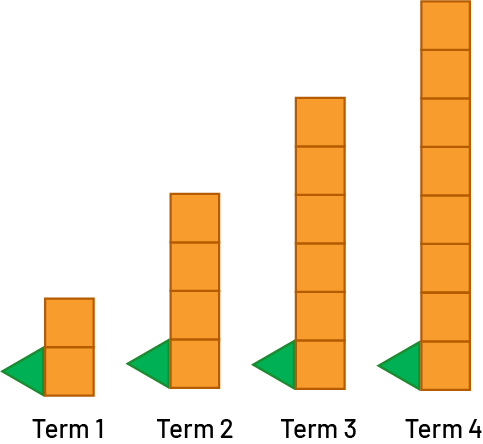 Image Geometric pattern of the term number and the
shapes.
term one, one green triangle and one group of two orange squares. term 2, one green triangle and 2 groups of
2
orange squares. term 3, one green triangle and 3 groups of 2 orange squares. term 4, one green triangle and
4
groups of 2 orange squares.
Image Geometric pattern of the term number and the
shapes.
term one, one green triangle and one group of two orange squares. term 2, one green triangle and 2 groups of
2
orange squares. term 3, one green triangle and 3 groups of 2 orange squares. term 4, one green triangle and
4
groups of 2 orange squares.|
Pattern rule: For any term there is one green triangle and the number of squares is twice the term number. |
